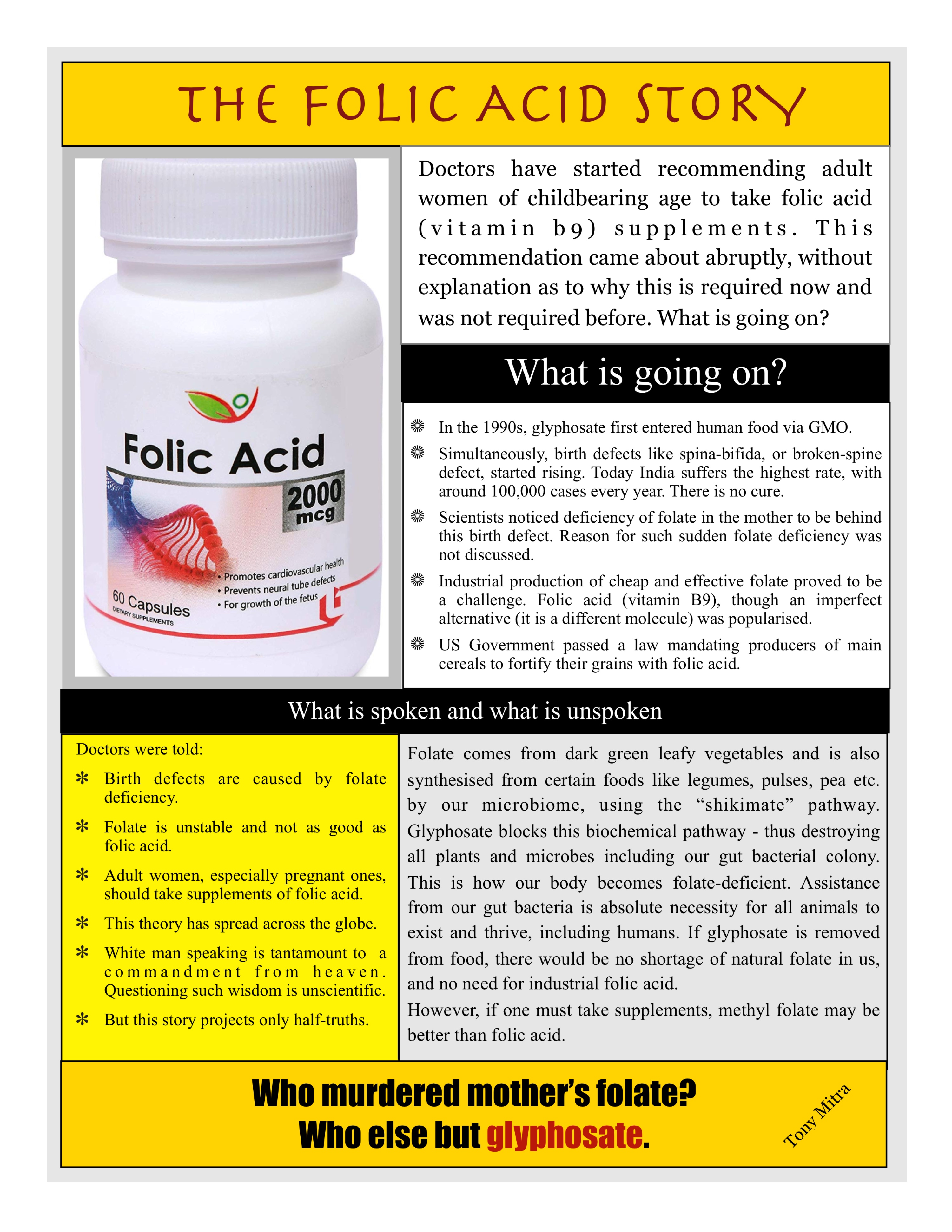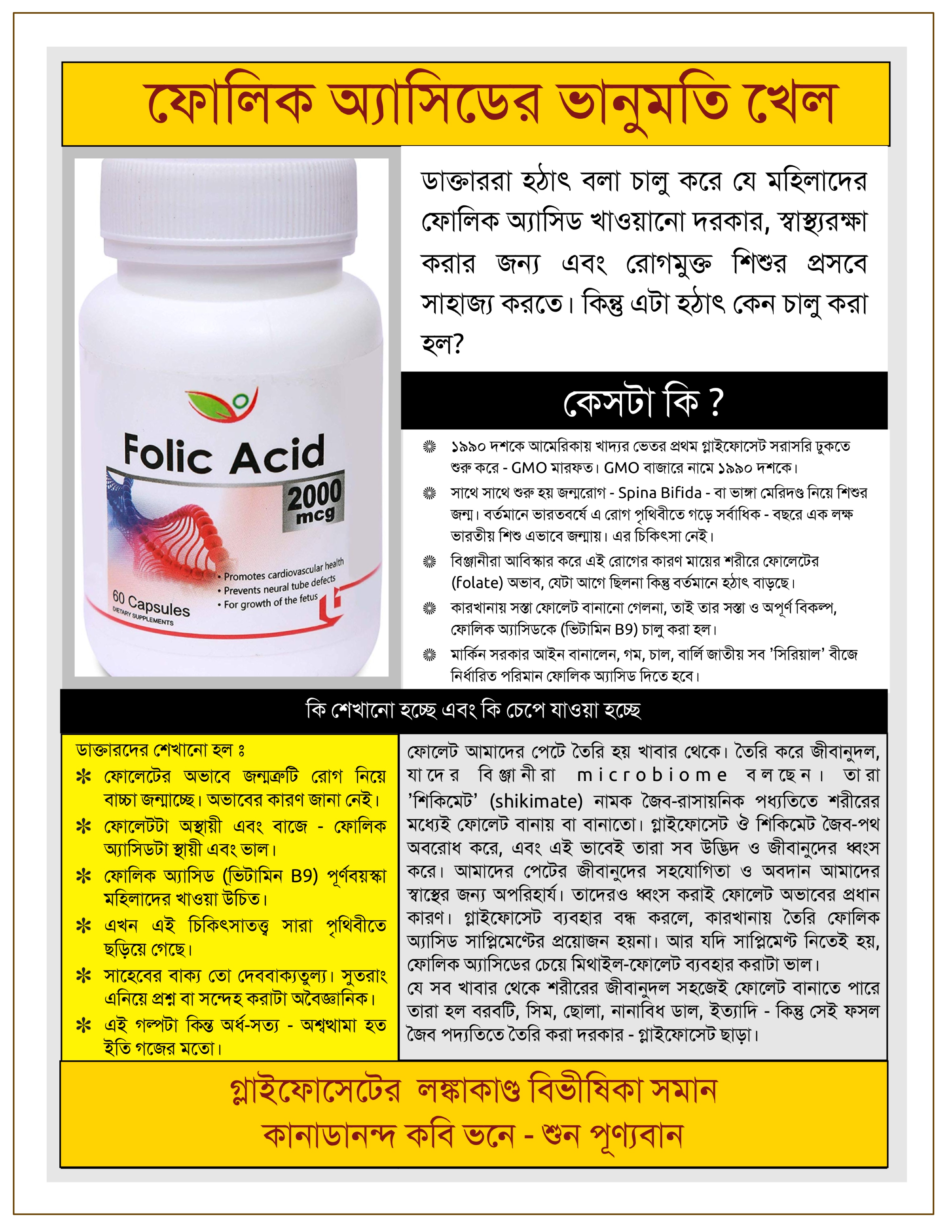The story started with the possible link between spina-bifida and glyphosate from the point of view of India.
I am visiting India right now. I have also been invited to speak at different venues about dangers of using glyphosate. There are pockets of India with high use of glyphosate, and there are reports of high occurrence of certain disease and birth defects. I have not gotten access to much reports and statistics and I get the impression that there is much room for data collection and analysis on this front.

However, I did come across the issue of spina-bifida, the broken-spine birth defect and its effects in Missions province of Argentina and also in India. In Argentina, they are using roundup ready tobacco. Women that were spraying glyphosate on those tobacco plants, were giving birth to many of the seriously deformed babies with damaged spinal column or damaged brain etc. Glyphosate was suspected to be the cause. Following that, and getting further information from scientists like Anthony Samsel and Stephanie Seneff, and also from the internet, I learned that deficiency of folate/ folic acid has links to this birth defect. Also, India apparently has the worlds highest rate (per thousand births) of spina bifida in the world, and four times higher than the world average.

There seemed to be a number of birth defects related to pregnant women being exposed to various toxins, of which glyphosate is one. The defects ranged from babies without a brain or having a deformed brain, to man-formed or broken spine. Some of these defects were identified under an umbrella term – Neural Tube Defect, or NTD. India had a high prevalence of that.
I was further advised by grassroots workers that the farming community needed to see these images of deformed babies, to fully grasp the potential harm that newborns can have, if adult women of childbearing age are engaged in handling toxic material. This is one way to make folks realise the overall dangers involved with agro-toxins.

Folate deficiency is reported to be at the root of some of these birth defects, such as spina-bifida or broken-spine disease. The story of folate itself appears to hide as much truth as it tells. The 1990s is when glyphosate started seriously entering human food through GMO. Later its presence increased through non-GMO desiccated seed crops. Along with the presence of glyphosate, birth defects such as spina-bifida started rising. scientists discovered a possible link between folate deficiency, especially during the first month of pregnancy, and spina-bifida. There is virtually no cure for this defect.
Fortification of seed crops with folic acid (a folate substitute) was made mandatory for suppliers of main cereals in the US back in the 1990s, the same time when glyphosate started entering human food in every increasing amount. Apparently, folic acid (vitamin B9) is not exactly the same thing as folate.
Stephanie Seneff told me that, when she was researching folate for her lecture, she noted that the gut microbes processed dietary folate into methyl tetrahydrofolate, but the same microbiome did not know what to do with the folic acid that was being added as fortification of wheat.
However, according to some scientists that perhaps influenced the US Government into proposing folic acid fortification, noted a reduction in spina-bifida birth defects with folic acid fortification of food. It is believed that liver gets over-taxed by demands to convert folic acid into methyl tetrahydrofolate, because our gut bacteria are unable to handle folic acid. Therefore, although some methyl tetrahydrofolate was eventually being produced by the body, which in turn reduced the rate of spina-bifida, our liver got overworked, and as a direct result of that our liver was then unable to engage in both methylation capacity and antioxidant capacity. In other words, folic acid helped solve one problem but created a few more in turn.
The lesson here is – removing glyphosate would have been the best solution, allowing our gut bacteria to do their job, than fortification of food with man made alternatives. Having said that, I am advised by Stephanie Seneff that, should one be incapable to reducing glyphosate from food, and must take supplements, methyl folate was better than folic acid.
There is another way glyphosate puts a spanner into the wheels. Its presence in folate producing plants that we eat, in itself interferes with the plant’s ability to do its work properly. This in turn reduces the plant’s production folate. As a result, glyphosate-laced plants ends up with more of the potential natural folate being bio-unavailable for us.
It is my opinion that the only thing good about glyphosate is that it makes money for some toxic corporations. It has no other positive. It should not be present on planet earth. Let them make a profit by supplying it to Jupiter.
To meet with a demand to have some of this material in local languages and not just English, I translated a few. Here is an example.

This will be another chapter in my book – Lonely Road.
Incidentally, I found methyl tetrahydrofolate is available in India, in 800 microgram tablets, about $8 (₹ 500) for 180 tablets. I am thinking of trying them out, but am waiting feedback from experts. The thing is – I am neither female, nor pregnant, nor in childbearing age. So, how much folate am I usually in need of ?
